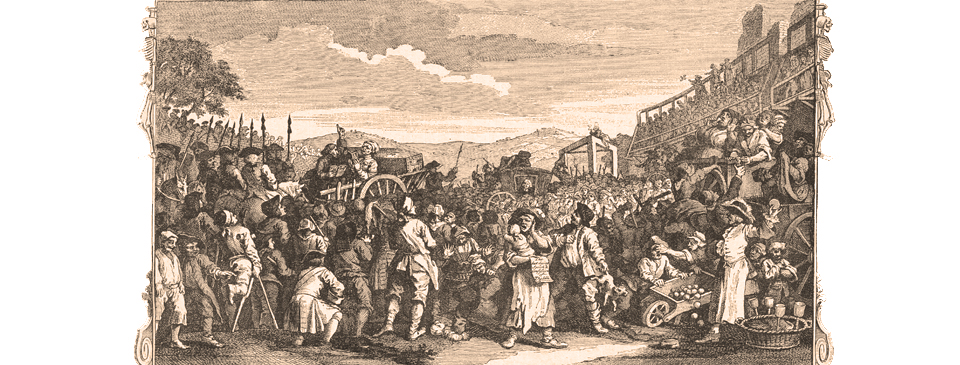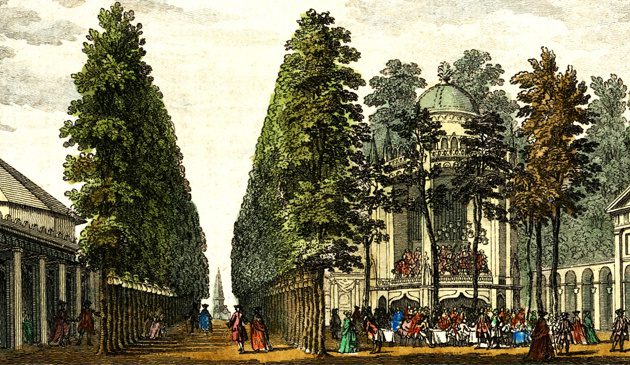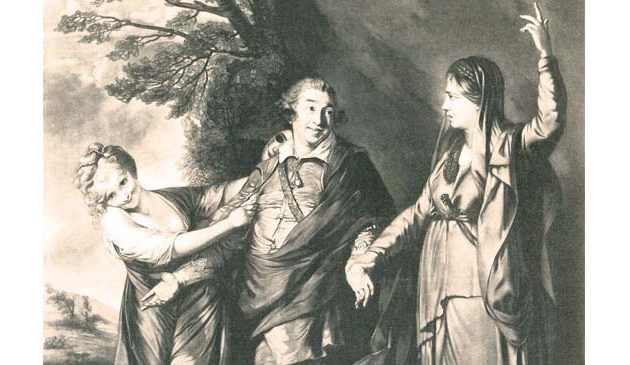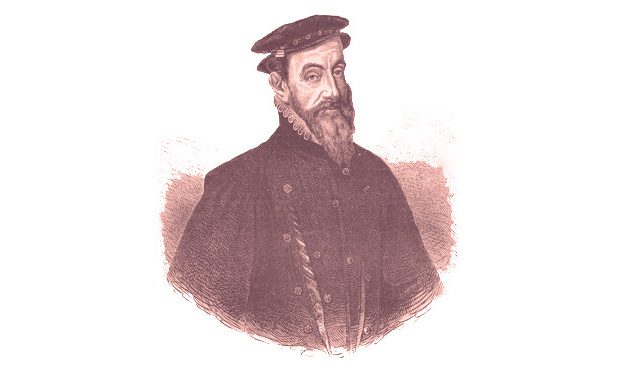William Hogarth

The final picture from William Hogarth’s series Industry & Idleness shows Thomas Idle arriving for his execution at the gallows at Tyburn, accompanied by his coffin. In the foreground the woman is selling fraudulent copies of “The last dying speech & confession of Tho. Idle”, which he clearly has not yet made, as often occurred at the time. Hogarth produced Industry & Idleness as a series of twelve prints, sold for one shilling each, in 1747.
As his stature within the small London art world grew during the second half of the 1730s, Hogarth increasingly became a champion and defender of English artists. He urged his fellows at the St. Martin’s Lane Academy, such as Allan Ramsay, to compete to produce portraits as fine as that by Van Dyke. They in turn challenged him to do the same and over the next few years he painted a number of portraits. By 1740 he had mastered the genre, as seen in that of Captain Thomas Coram. Hogarth’s first full-length portrait, it is very much in the style of Van Dyke.
The shipwright and businessman Coram had spent many years lobbying and petitioning for the establishment of a hospital for abandoned children. The artist became a founding member of the board of the Foundling Hospital and designed the letterhead of the hospital’s official fund-raising appeal. Having provided his portrait of Coram to the orphanage, Hogarth soon realized the potential of the institution as a way of promoting the work of British artists. He and several others presented historical works to hang in the Court Room of the new building at Bloomsbury, thus creating the earliest public art gallery in London.
In the early 1740s Hogarth returned to what he was best-known for, creating a third series of paintings to follow The Harlot’s Progress and The Rake’s Progress. Marriage à la Mode, a commentary on arranged marriages, bourgeois aspirations and foreign art, is unmistakably Hogarth but with less low-comedy and exaggeration than the previous two series.
One of Hogarth’s group of friends was the actor David Garrick, who was still an aspiring actor when they first met. Garrick then shot to sudden fame and by 1745 was the great star at Drury Lane. Hogarth and Garrick inspired each other. Hogarth took a commission to paint a portrait of Garrick but chose to portray him as he appeared on stage as Richard III at one of the most dramatic moments in the play in which he had made his name.
The March to Finchley is yet another of Hogarth’s paintings that could easily be set on a stage. The drama is set in 1745 at Tottenham Court Road – then on the edge of London – as troops assemble for their march to confront ‘Bonnie Prince Charlie’ and his army who were marching towards London. Hogarth sold the painting in the form of a lottery prize. The winning ticket was held by the Foundling Hospital where it remains on display today.
From the time of their marriage, William and Jane had rented summer lodgings but in September 1749 they purchased a country house close to the Thames in the quiet village of Chiswick.
In 1751 the Gin Act was being passed by Parliament to try to combat the rampant addiction of the drink. Hogarth produced two prints, which were “calculated to reform some reigning vices peculiar to the lower Class of People” and that he “had published them in the cheapest Manner possible”. In other words, Beer Street and Gin Lane were designed to show people the error of their ways and he was therefore making them available at a price that would achieve the widest possible distribution amongst those people to whom his message was aimed.
By the 1750s Hogarth was reaching the zenith of his artistic and satirical achievements, as can be seen in the last of his ‘moral subject’ series of paintings, An Election Entertainment, which mocked the corrupt British election system of the time. His popularity was by then on the wane and, worried that Hogarth would be unable to sell them at a reasonable price, his wealthy friend Garrick stepped in to purchase the original paintings. Although he still had some years of fine work before him, Hogarth was rarely to rise to the same level that he achieved with An Election.
Despite his original intention that the St. Martin’s Lane Academy should be a democratic club, some members felt that it was dominated by the autocratic views of Hogarth and others and sought change. A new group of artists had emerged who wished to create an official art academy along the lines of the Académie Française in Paris. Some of the younger artists, including Joshua Reynolds, were beginning to mock Hogarth and in his old age he retreated from, and became isolated from, the London art world.


